2016 SUBARU BRZ engine
[x] Cancel search: enginePage 427 of 490
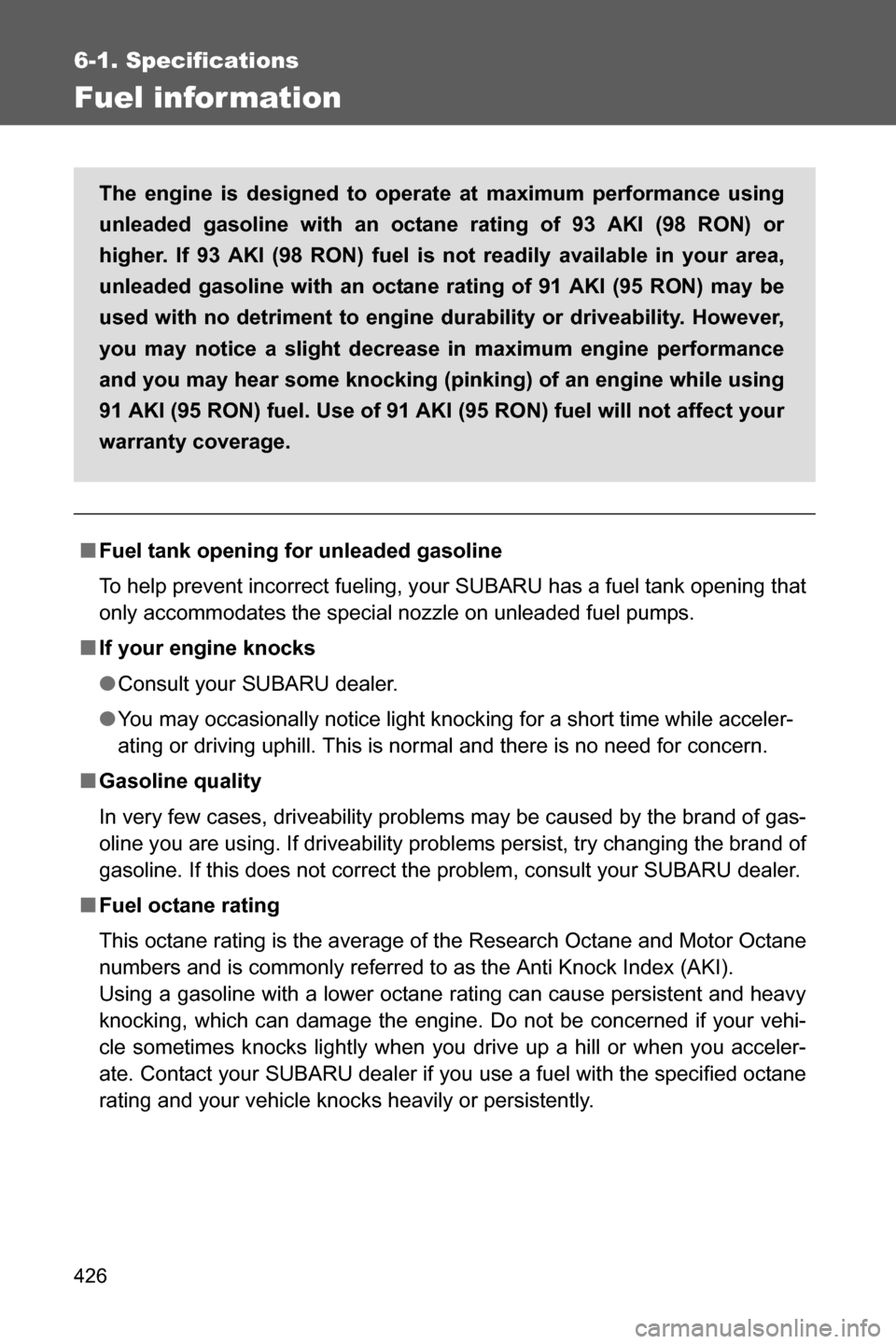
426
6-1. Specifications
Fuel infor mation
■Fuel tank opening for unleaded gasoline
To help prevent incorrect fueling, your SUBARU has a fuel tank opening that
only accommodates the special nozzle on unleaded fuel pumps.
■If your engine knocks
●Consult your SUBARU dealer.
●You may occasionally notice light knocking for a short time while acceler-
ating or driving uphill. This is normal and there is no need for concern.
■Gasoline quality
In very few cases, driveability problems may be caused by the brand of gas-
oline you are using. If driveability problems persist, try changing the brand of
gasoline. If this does not correct the problem, consult your SUBARU dealer.
■Fuel octane rating
This octane rating is the average of the Research Octane and Motor Octane
numbers and is commonly referred to as the Anti Knock Index (AKI).
Using a gasoline with a lower octane rating can cause persistent and heavy
knocking, which can damage the engine. Do not be concerned if your vehi-
cle sometimes knocks lightly when you drive up a hill or when you acceler-
ate. Contact your SUBARU dealer if you use a fuel with the specified octane
rating and your vehicle knocks heavily or persistently. The engine is designed to operate at maximum performance using
unleaded gasoline with an octane rating of 93 AKI (98 RON) or
higher. If 93 AKI (98 RON) fuel is not readily available in your area,
unleaded gasoline with an octane rating of 91 AKI (95 RON) may be
used with no detriment to engine durability or driveability. However,
you may notice a slight decrease in maximum engine performance
and you may hear some knocking (pinking) of an engine while using
91 AKI (95 RON) fuel. Use of 91 AKI (95 RON) fuel will not affect your
warranty coverage.
Page 428 of 490
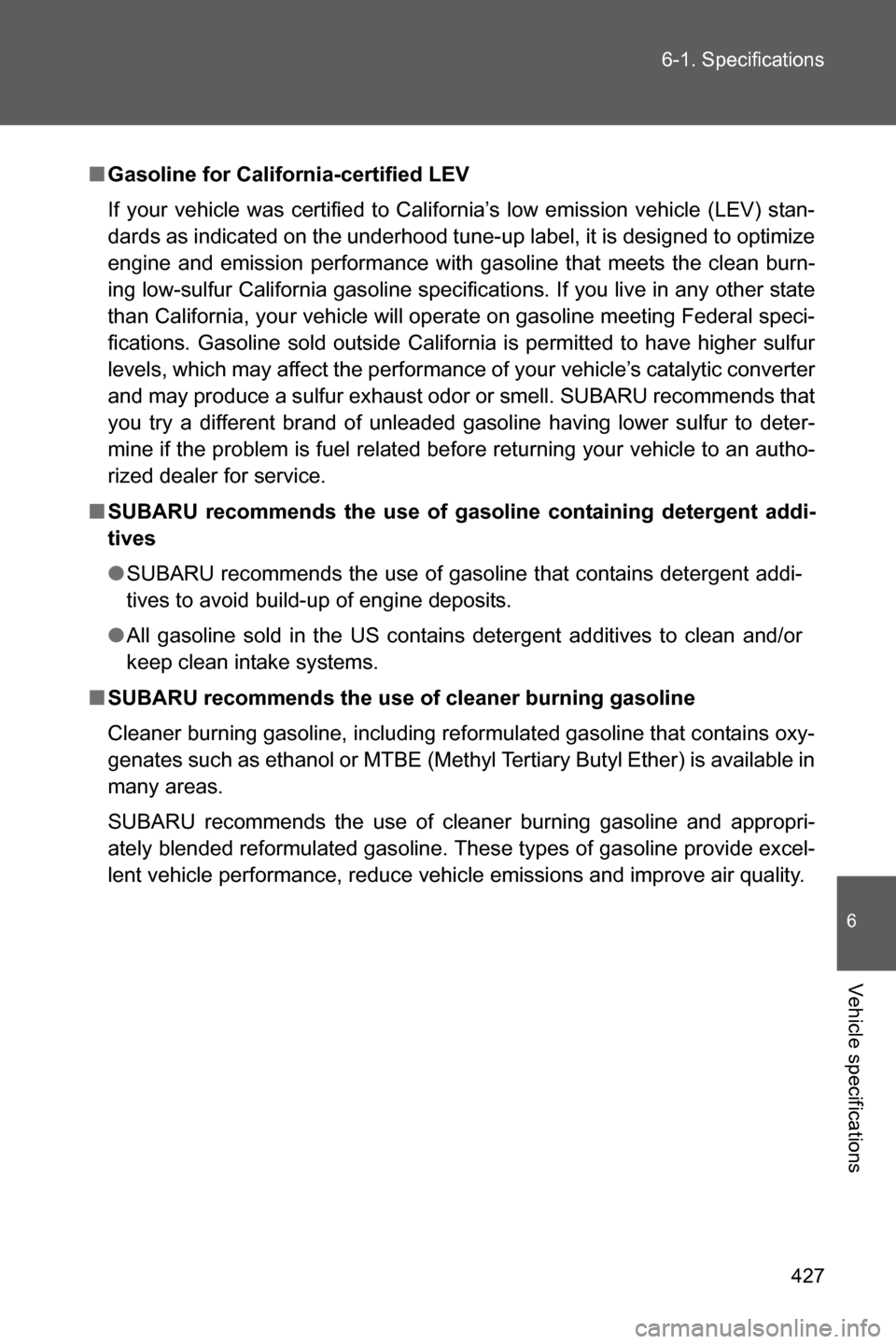
427 6-1. Specifications
6
Vehicle specifications
■Gasoline for California-certified LEV
If your vehicle was certified to California’s low emission vehicle (LEV) stan-
dards as indicated on the underhood tune-up label, it is designed to optimize
engine and emission performance with gasoline that meets the clean burn-
ing low-sulfur California gasoline specifications. If you live in any other state
than California, your vehicle will operate on gasoline meeting Federal speci-
fications. Gasoline sold outside California is permitted to have higher sulfur
levels, which may affect the performance of your vehicle’s catalytic converter
and may produce a sulfur exhaust odor or smell. SUBARU recommends that
you try a different brand of unleaded gasoline having lower sulfur to deter-
mine if the problem is fuel related before returning your vehicle to an autho-
rized dealer for service.
■SUBARU recommends the use of gasoline containing detergent addi-
tives
●SUBARU recommends the use of gasoline that contains detergent addi-
tives to avoid build-up of engine deposits.
●All gasoline sold in the US contains detergent additives to clean and/or
keep clean intake systems.
■SUBARU recommends the use of cleaner burning gasoline
Cleaner burning gasoline, including reformulated gasoline that contains oxy-
genates such as ethanol or MTBE (Methyl Tertiary Butyl Ether) is available in
many areas.
SUBARU recommends the use of cleaner burning gasoline and appropri-
ately blended reformulated gasoline. These types of gasoline provide excel-
lent vehicle performance, reduce vehicle emissions and improve air quality.
Page 430 of 490
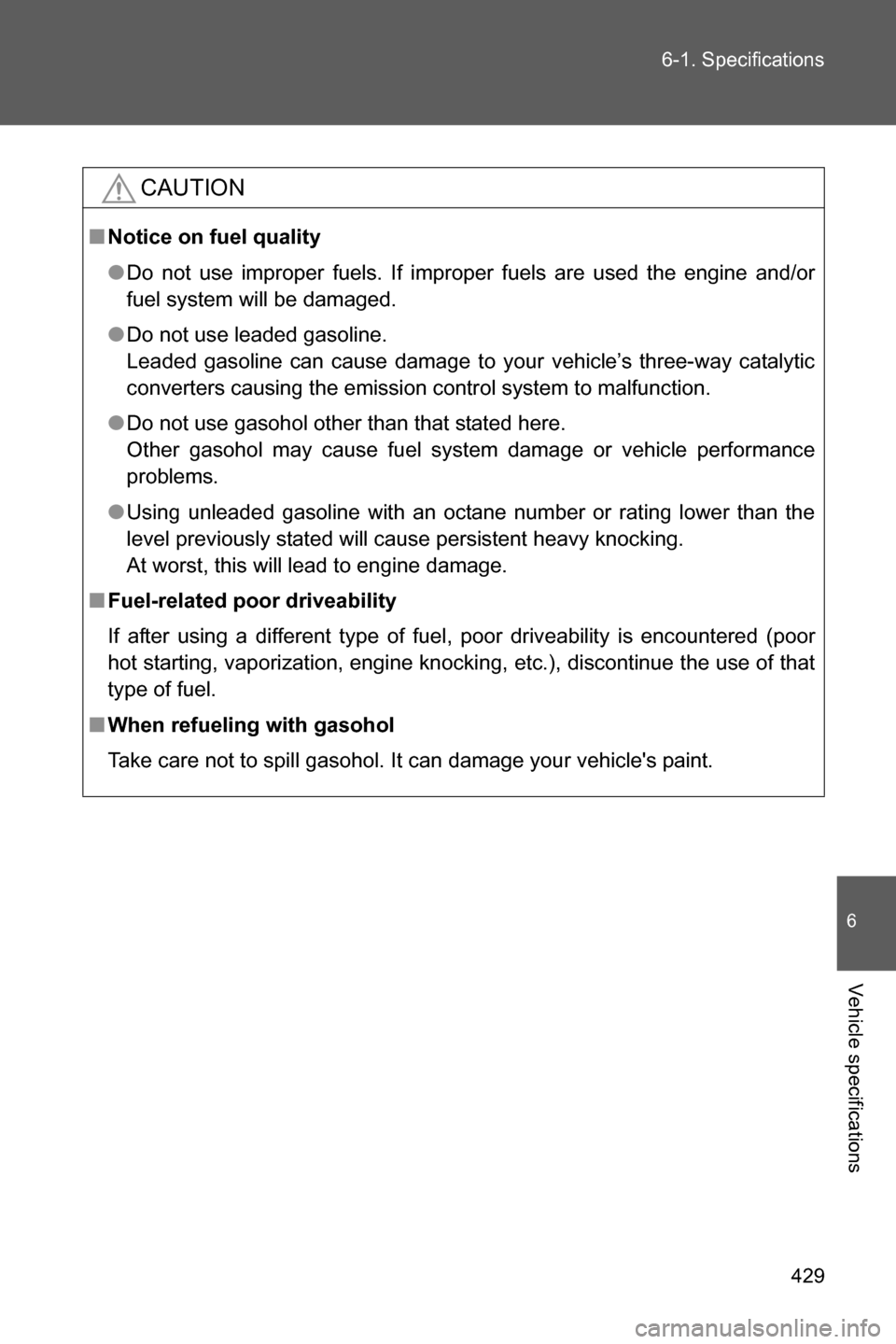
429 6-1. Specifications
6
Vehicle specifications
CAUTION
■Notice on fuel quality
●Do not use improper fuels. If improper fuels are used the engine and/or
fuel system will be damaged.
●Do not use leaded gasoline.
Leaded gasoline can cause damage to your vehicle’s three-way catalytic
converters causing the emission control system to malfunction.
●Do not use gasohol other than that stated here.
Other gasohol may cause fuel system damage or vehicle performance
problems.
●Using unleaded gasoline with an octane number or rating lower than the
level previously stated will cause persistent heavy knocking.
At worst, this will lead to engine damage.
■Fuel-related poor driveability
If after using a different type of fuel, poor driveability is encountered (poor
hot starting, vaporization, engine knocking, etc.), discontinue the use of that
type of fuel.
■When refueling with gasohol
Take care not to spill gasohol. It can damage your vehicle's paint.
Page 437 of 490

436 6-1. Specifications
Warning: The temperature grades of a tire assume that it is properly
inflated and not overloaded.
Excessive speed, underinflation, or excessive loading, either sepa-
rately or in combination, can cause heat buildup and possible tire fail-
ure.
Glossary of tire terminology
Tire related termMeaning
Cold tire inflation
pressureTire pressure when the vehicle has been
parked for three hours or more, or has not
been driven more than 1 mile or 1.5 km under
that condition
Maximum inflation
pressureThe maximum cold inflated pressure to which a
tire may be inflated, shown on the sidewall of
the tire
Recommended
inflation pressureCold tire inflation pressure recommended by a
manufacturer.
Accessory weightThe combined weight (in excess of those stan-
dard items which may be replaced) of auto-
matic transmission, power steering, power
brakes, power windows, power seats, radio
and heater, to the extent that these items are
available as factory-installed equipment
(whether installed or not)
Curb weightThe weight of a motor vehicle with standard
equipment, including the maximum capacity of
fuel, oil and coolant, and if so equipped, air
conditioning and additional weight optional
engine
Maximum loaded
vehicle weightThe sum of:
(a) Curb weight
(b) Accessory weight
(c) Vehicle capacity weight
(d) Production options weight
Page 446 of 490
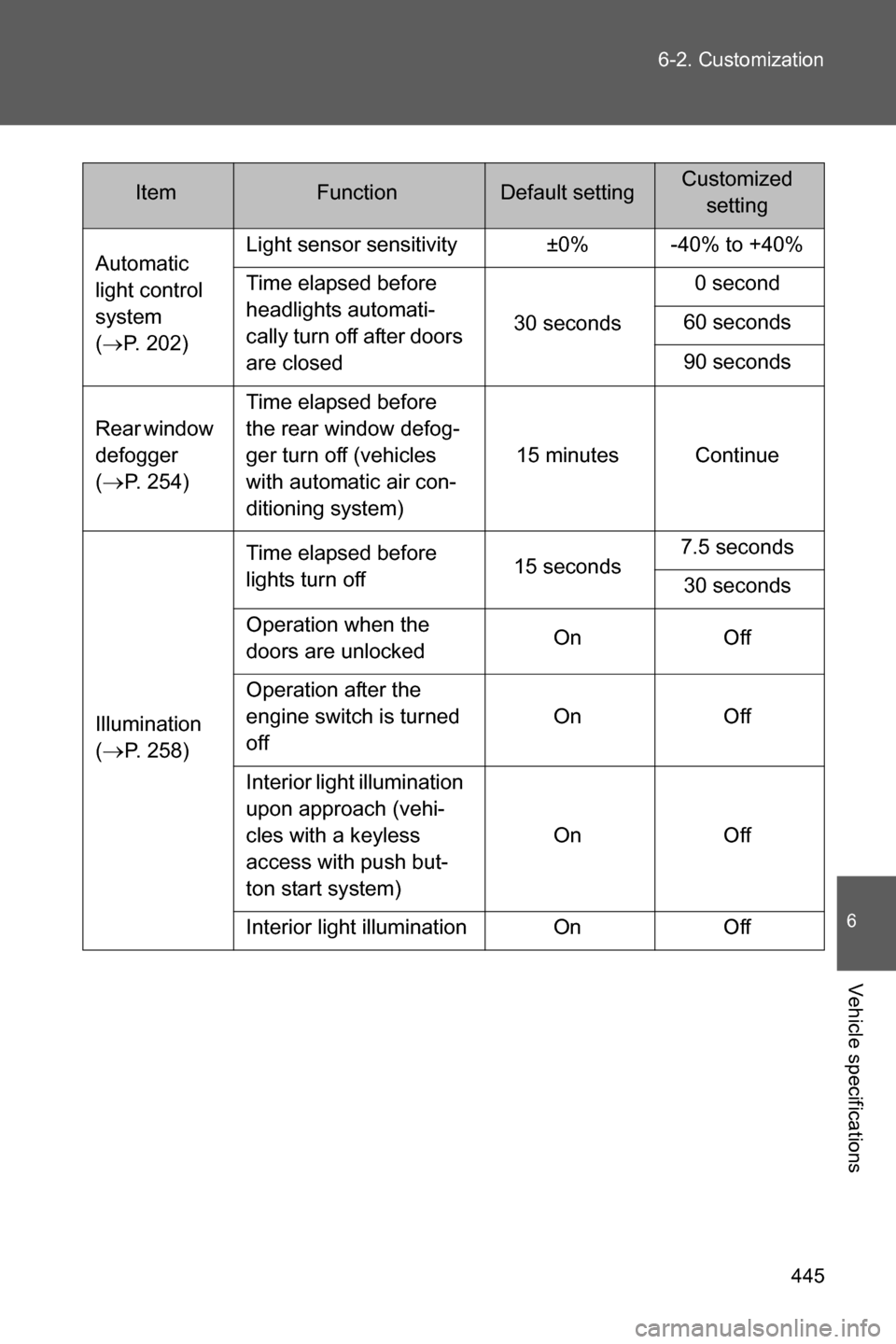
445 6-2. Customization
6
Vehicle specifications
Automatic
light control
system
(�oP. 202)Light sensor sensitivity ±0% -40% to +40%
Time elapsed before
headlights automati-
cally turn off after doors
are closed30 seconds0 second
60 seconds
90 seconds
Rear window
defogger
(
�oP. 254)Time elapsed before
the rear window defog-
ger turn off (vehicles
with automatic air con-
ditioning system)15 minutes Continue
Illumination
(
�oP. 258)Time elapsed before
lights turn off15 seconds7.5 seconds
30 seconds
Operation when the
doors are unlockedOn Off
Operation after the
engine switch is turned
offOn Off
Interior light illumination
upon approach (vehi-
cles with a keyless
access with push but-
ton start system)On Off
Interior light illumination On Off
ItemFunctionDefault settingCustomized
setting
Page 477 of 490
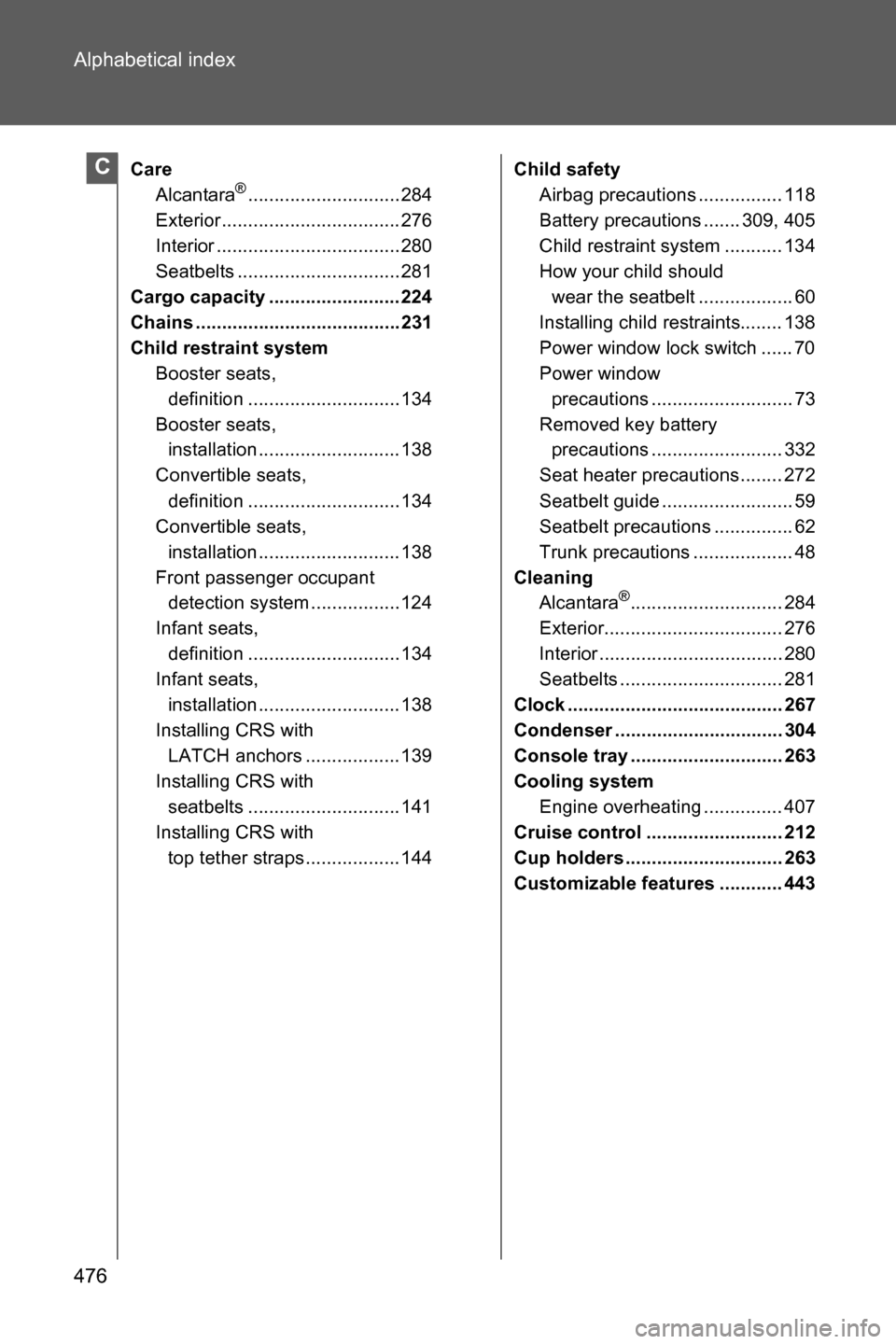
476 Alphabetical index
Care
Alcantara®............................. 284
Exterior.................................. 276
Interior ................................... 280
Seatbelts ............................... 281
Cargo capacity ......................... 224
Chains ....................................... 231
Child restraint system
Booster seats,
definition ............................. 134
Booster seats,
installation ........................... 138
Convertible seats,
definition ............................. 134
Convertible seats,
installation ........................... 138
Front passenger occupant
detection system .................124
Infant seats,
definition ............................. 134
Infant seats,
installation ........................... 138
Installing CRS with
LATCH anchors .................. 139
Installing CRS with
seatbelts ............................. 141
Installing CRS with
top tether straps .................. 144Child safety
Airbag precautions ................ 118
Battery precautions ....... 309, 405
Child restraint system ........... 134
How your child should
wear the seatbelt .................. 60
Installing child restraints........ 138
Power window lock switch ...... 70
Power window
precautions ........................... 73
Removed key battery
precautions ......................... 332
Seat heater precautions ........ 272
Seatbelt guide ......................... 59
Seatbelt precautions ............... 62
Trunk precautions ................... 48
Cleaning
Alcantara
®............................. 284
Exterior.................................. 276
Interior ................................... 280
Seatbelts ............................... 281
Clock ......................................... 267
Condenser ................................ 304
Console tray ............................. 263
Cooling system
Engine overheating ............... 407
Cruise control .......................... 212
Cup holders .............................. 263
Customizable features ............ 443
C
Page 478 of 490
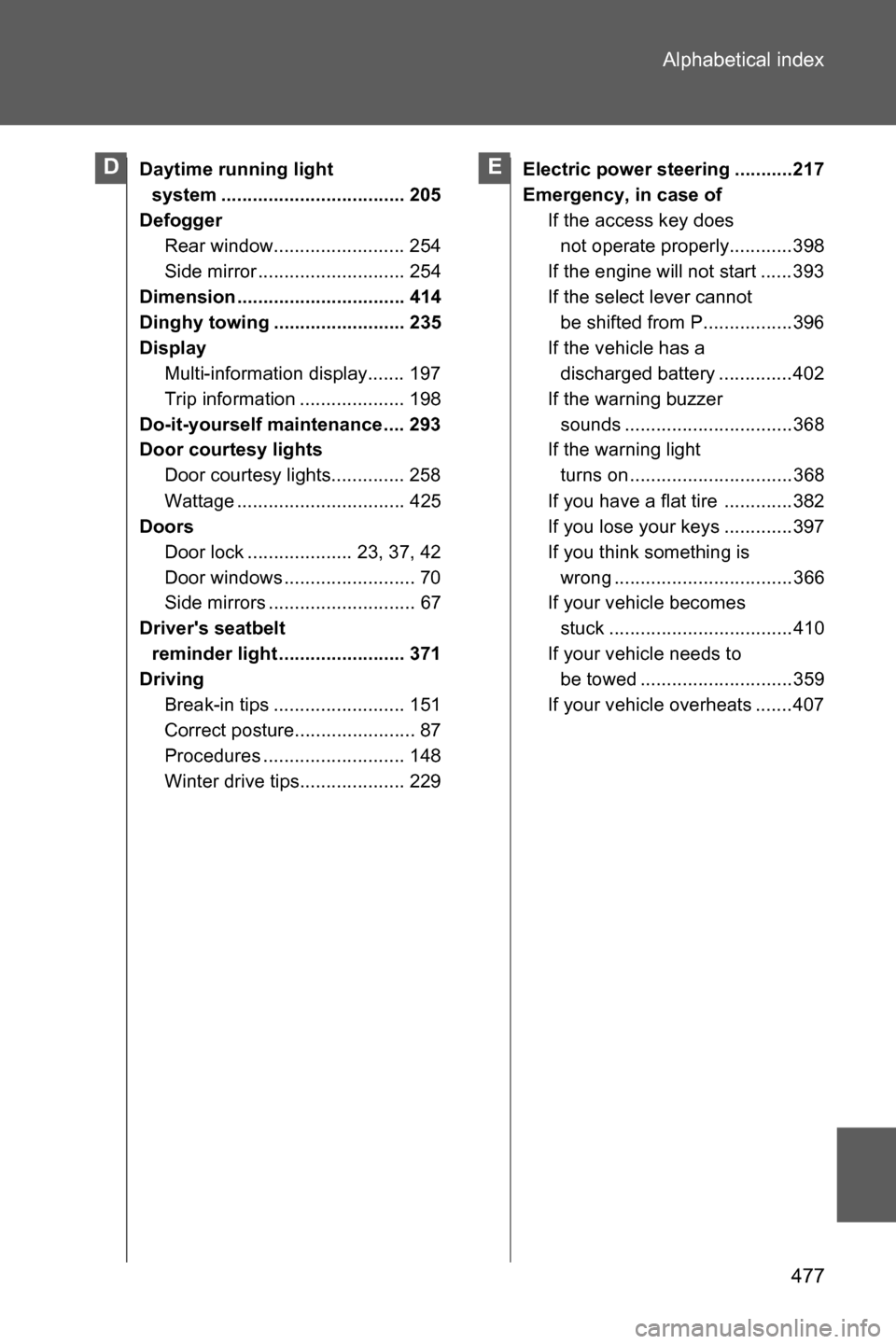
477 Alphabetical index
Daytime running light
system ................................... 205
Defogger
Rear window......................... 254
Side mirror ............................ 254
Dimension ................................ 414
Dinghy towing ......................... 235
Display
Multi-information display....... 197
Trip information .................... 198
Do-it-yourself maintenance .... 293
Door courtesy lights
Door courtesy lights.............. 258
Wattage ................................ 425
Doors
Door lock .................... 23, 37, 42
Door windows ......................... 70
Side mirrors ............................ 67
Driver's seatbelt
reminder light ........................ 371
Driving
Break-in tips ......................... 151
Correct posture....................... 87
Procedures ........................... 148
Winter drive tips.................... 229Electric power steering ...........217
Emergency, in case of
If the access key does
not operate properly............398
If the engine will not start ......393
If the select lever cannot
be shifted from P.................396
If the vehicle has a
discharged battery ..............402
If the warning buzzer
sounds ................................368
If the warning light
turns on ...............................368
If you have a flat tire .............382
If you lose your keys .............397
If you think something is
wrong ..................................366
If your vehicle becomes
stuck ...................................410
If your vehicle needs to
be towed .............................359
If your vehicle overheats ....... 407DE
Page 479 of 490
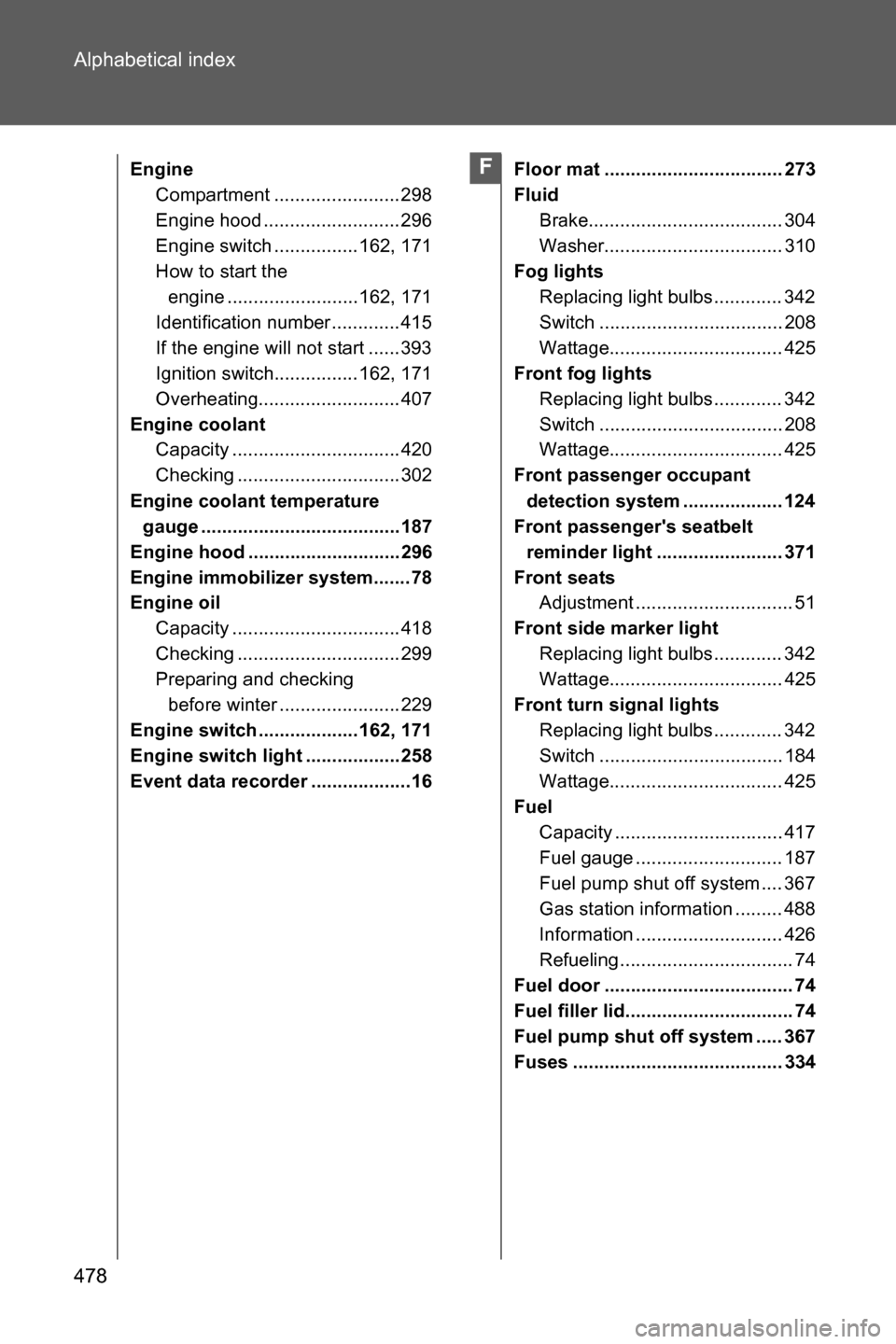
478 Alphabetical index
Engine
Compartment ........................ 298
Engine hood .......................... 296
Engine switch ................162, 171
How to start the
engine .........................162, 171
Identification number............. 415
If the engine will not start ...... 393
Ignition switch................162, 171
Overheating........................... 407
Engine coolant
Capacity ................................ 420
Checking ............................... 302
Engine coolant temperature
gauge ...................................... 187
Engine hood ............................. 296
Engine immobilizer system....... 78
Engine oil
Capacity ................................ 418
Checking ............................... 299
Preparing and checking
before winter ....................... 229
Engine switch ...................162, 171
Engine switch light .................. 258
Event data recorder ...................16Floor mat .................................. 273
Fluid
Brake..................................... 304
Washer.................................. 310
Fog lights
Replacing light bulbs ............. 342
Switch ................................... 208
Wattage................................. 425
Front fog lights
Replacing light bulbs ............. 342
Switch ................................... 208
Wattage................................. 425
Front passenger occupant
detection system ................... 124
Front passenger's seatbelt
reminder light ........................ 371
Front seats
Adjustment .............................. 51
Front side marker light
Replacing light bulbs ............. 342
Wattage................................. 425
Front turn signal lights
Replacing light bulbs ............. 342
Switch ................................... 184
Wattage................................. 425
Fuel
Capacity ................................ 417
Fuel gauge ............................ 187
Fuel pump shut off system .... 367
Gas station information ......... 488
Information ............................ 426
Refueling................................. 74
Fuel door .................................... 74
Fuel filler lid................................ 74
Fuel pump shut off system ..... 367
Fuses ........................................ 334F